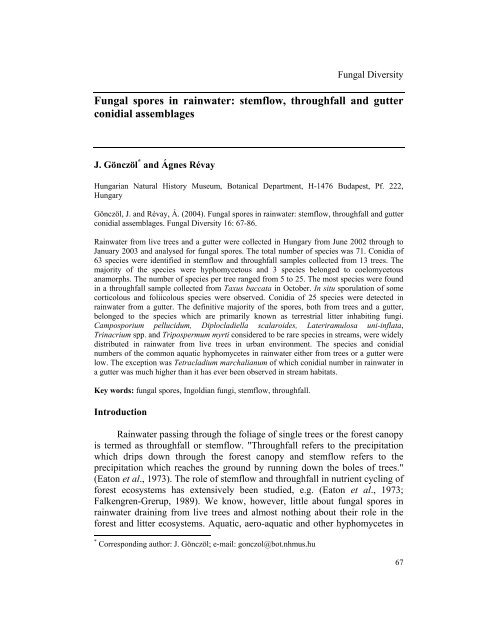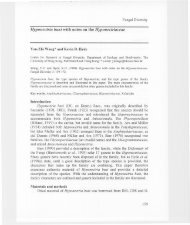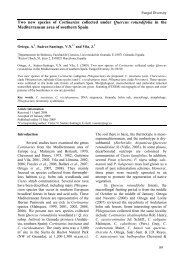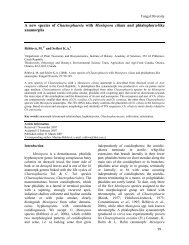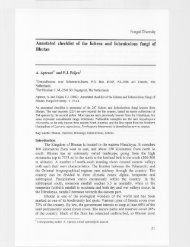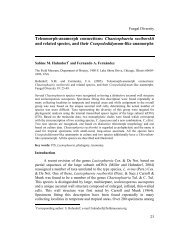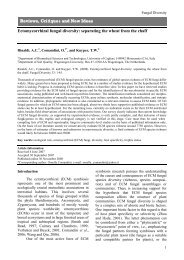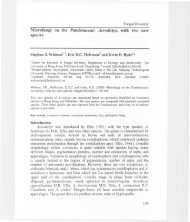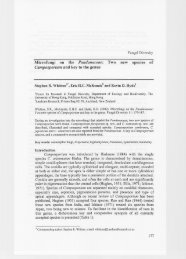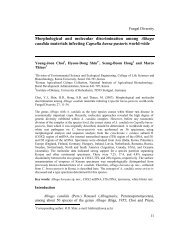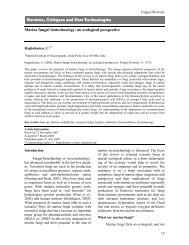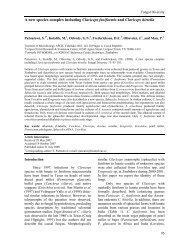Fungal spores in rainwater: stemflow, throughfall ... - Fungal diversity
Fungal spores in rainwater: stemflow, throughfall ... - Fungal diversity
Fungal spores in rainwater: stemflow, throughfall ... - Fungal diversity
Create successful ePaper yourself
Turn your PDF publications into a flip-book with our unique Google optimized e-Paper software.
<strong>Fungal</strong> Diversity<br />
<strong>Fungal</strong> <strong>spores</strong> <strong>in</strong> ra<strong>in</strong>water: <strong>stemflow</strong>, <strong>throughfall</strong> and gutter<br />
conidial assemblages<br />
J. Gönczöl * and Ágnes Révay<br />
Hungarian Natural History Museum, Botanical Department, H-1476 Budapest, Pf. 222,<br />
Hungary<br />
Gönczöl, J. and Révay, Á. (2004). <strong>Fungal</strong> <strong>spores</strong> <strong>in</strong> ra<strong>in</strong>water: <strong>stemflow</strong>, <strong>throughfall</strong> and gutter<br />
conidial assemblages. <strong>Fungal</strong> Diversity 16: 67-86.<br />
Ra<strong>in</strong>water from live trees and a gutter were collected <strong>in</strong> Hungary from June 2002 through to<br />
January 2003 and analysed for fungal <strong>spores</strong>. The total number of species was 71. Conidia of<br />
63 species were identified <strong>in</strong> <strong>stemflow</strong> and <strong>throughfall</strong> samples collected from 13 trees. The<br />
majority of the species were hyphomycetous and 3 species belonged to coelomycetous<br />
anamorphs. The number of species per tree ranged from 5 to 25. The most species were found<br />
<strong>in</strong> a <strong>throughfall</strong> sample collected from Taxus baccata <strong>in</strong> October. In situ sporulation of some<br />
corticolous and foliicolous species were observed. Conidia of 25 species were detected <strong>in</strong><br />
ra<strong>in</strong>water from a gutter. The def<strong>in</strong>itive majority of the <strong>spores</strong>, both from trees and a gutter,<br />
belonged to the species which are primarily known as terrestrial litter <strong>in</strong>habit<strong>in</strong>g fungi.<br />
Camposporium pellucidum, Diplocladiella scalaroides, Lateriramulosa uni-<strong>in</strong>flata,<br />
Tr<strong>in</strong>acrium spp. and Tripospermum myrti considered to be rare species <strong>in</strong> streams, were widely<br />
distributed <strong>in</strong> ra<strong>in</strong>water from live trees <strong>in</strong> urban environment. The species and conidial<br />
numbers of the common aquatic hyphomycetes <strong>in</strong> ra<strong>in</strong>water either from trees or a gutter were<br />
low. The exception was Tetracladium marchalianum of which conidial number <strong>in</strong> ra<strong>in</strong>water <strong>in</strong><br />
a gutter was much higher than it has ever been observed <strong>in</strong> stream habitats.<br />
Key words: fungal <strong>spores</strong>, Ingoldian fungi, <strong>stemflow</strong>, <strong>throughfall</strong>.<br />
Introduction<br />
Ra<strong>in</strong>water pass<strong>in</strong>g through the foliage of s<strong>in</strong>gle trees or the forest canopy<br />
is termed as <strong>throughfall</strong> or <strong>stemflow</strong>. "Throughfall refers to the precipitation<br />
which drips down through the forest canopy and <strong>stemflow</strong> refers to the<br />
precipitation which reaches the ground by runn<strong>in</strong>g down the boles of trees."<br />
(Eaton et al., 1973). The role of <strong>stemflow</strong> and <strong>throughfall</strong> <strong>in</strong> nutrient cycl<strong>in</strong>g of<br />
forest ecosystems has extensively been studied, e.g. (Eaton et al., 1973;<br />
Falkengren-Grerup, 1989). We know, however, little about fungal <strong>spores</strong> <strong>in</strong><br />
ra<strong>in</strong>water dra<strong>in</strong><strong>in</strong>g from live trees and almost noth<strong>in</strong>g about their role <strong>in</strong> the<br />
forest and litter ecosystems. Aquatic, aero-aquatic and other hyphomycetes <strong>in</strong><br />
* Correspond<strong>in</strong>g author: J. Gönczöl; e-mail: gonczol@bot.nhmus.hu<br />
67
natural water bodies, mostly <strong>in</strong> streams, have extensively been studied s<strong>in</strong>ce<br />
the pioneer work of Ingold (1942), but this is not the case with hyphomycetes<br />
<strong>in</strong> ra<strong>in</strong>water. In an early study, unusual, mostly unknown conidia were reported<br />
from a foam sample collected on the trunk of a beech tree <strong>in</strong> SW Hungary<br />
(Gönczöl, 1976). This foam was formed on the trunk dur<strong>in</strong>g a summer<br />
ra<strong>in</strong>storm and it was obvious that it had accumulated from ra<strong>in</strong>water trickl<strong>in</strong>g<br />
along the tree trunk. In a recent study we analysed fungal species composition<br />
of water-filled treeholes <strong>in</strong> Hungary (Gönczöl and Révay, 2003). Laboratory<br />
<strong>in</strong>cubation of leaf and woody substrates collected from these treeholes yielded<br />
many grow<strong>in</strong>g and sporulat<strong>in</strong>g species of hyphomycetes. Some of them<br />
(<strong>in</strong>clud<strong>in</strong>g aquatic hyphomycetes) appeared to be persistent <strong>in</strong>habitants <strong>in</strong><br />
treeholes. It was suspected, however, that some other species, only seen as<br />
conidia but not fruit<strong>in</strong>g on the substrates, had entered the treeholes with<br />
ra<strong>in</strong>water. An endophytic or epiphytic orig<strong>in</strong> was also suspected. Water-filled<br />
treeholes appear to be an occasional trap rather than a suitable habitat of these<br />
fungi.<br />
There are studies suggest<strong>in</strong>g active existence of some aquatic<br />
hyphomycetes on live trees. Bandoni (1981) <strong>in</strong>vestigated <strong>spores</strong> <strong>in</strong> <strong>stemflow</strong> of<br />
several trees <strong>in</strong> a forested area <strong>in</strong> British Columbia, Canada and found conidia<br />
of some species conventionally treated among aquatic hyphomycetes (e.g.<br />
Gyoerffyella biappendiculata, Gy. gemellipara). Tripospermum spp. of which<br />
aquatic or terrestrial habit is less known, also occurred <strong>in</strong> his samples. Japanese<br />
workers made extensive studies on hyphomycetes collected <strong>in</strong> ra<strong>in</strong>water<br />
dripp<strong>in</strong>g off trees. Ando and Tubaki (1984a,b) recorded conidia of<br />
Flabellospora spp., Articulospora sp. and many other species with<br />
stauroconidia similar <strong>in</strong> shape to Ingoldian fungi from ra<strong>in</strong>water collected from<br />
<strong>in</strong>tact leaves of trees. They were on the op<strong>in</strong>ion that ra<strong>in</strong>, fog and morn<strong>in</strong>g dew<br />
are adequate to create an aquatic habitat <strong>in</strong> a terrestrial condition. By their<br />
hypothesis these species "probably live usually on <strong>in</strong>tact leaves as mycelia and<br />
can sporulate when leaves are moistened by mist, morn<strong>in</strong>g dew or ra<strong>in</strong>. Also,<br />
when the leaves fall <strong>in</strong> aquatic habitats... those fungi may sporulate on them."<br />
Moreover they described a number of new species and genera from ra<strong>in</strong>water,<br />
mostly from <strong>throughfall</strong>, e.g. Dicranidion fissile, Tricladiella pluvialis,<br />
Tripospermum <strong>in</strong>falcatum, Alatosessilispora bibrachiata, Curucispora<br />
ombrogena (Ando and Tubaki, 1984a,b). Later the term "terrestrial aquatic<br />
hyphomycetes" was proposed for the group of these fungi, which was<br />
characterised by the staurosporous conidia and the micronematous<br />
conidiophores (Ando, 1992).<br />
Recently, Czeczuga and Orlowska (1994, 1999) reported a great number<br />
of hyphomycete species found <strong>in</strong> ra<strong>in</strong>water from liv<strong>in</strong>g trees <strong>in</strong> Poland. Quite a<br />
68
<strong>Fungal</strong> Diversity<br />
few aquatic hyphomycetes, formerly well known from aquatic habitats, e.g.<br />
Act<strong>in</strong>osporella megalospora, Anguillospora pseudolongissima, Clavariopsis<br />
brachycladia, Lemonniera aquatica and Margaritispora aquatica, were<br />
reported (Czeczuga and Orlowska, 1994). Unfortunately few details were given<br />
about their collect<strong>in</strong>g and <strong>in</strong>cubation techniques. In another paper Czeczuga<br />
and Orlowska (1999) recorded 57 ma<strong>in</strong>ly dematiaceous and aero-aquatic<br />
hyphomycetes and some noteworthy aquatic hyphomycete species, e.g.<br />
Articulospora prolifera, Colispora elongata, Pleuropedium tricladioides and<br />
Sigmoidea prolifera, <strong>in</strong> ra<strong>in</strong>water dra<strong>in</strong><strong>in</strong>g from trees. In this paper they also<br />
listed 33 species observed <strong>in</strong> ra<strong>in</strong>water from gutters and roofs of several<br />
build<strong>in</strong>gs. The occurrence of conidia of aquatic hyphomycete species, such as,<br />
Clavariana aquatica, Arbuscul<strong>in</strong>a irregularis, Colispora elongata and<br />
Lunulospora curvula, are also unexpected <strong>in</strong> these habitats.<br />
The literature data and our prelim<strong>in</strong>ary studies suggest that analysis of<br />
the <strong>spores</strong> <strong>in</strong> ra<strong>in</strong>water, primarily from live trees, may contribute to our<br />
knowledge about biology and distribution of aquatic and other hyphomycetes.<br />
Therefore our objectives <strong>in</strong> this study were: (1) to identify conidia of<br />
hyphomycete species <strong>in</strong> ra<strong>in</strong>water collected from live trees, ma<strong>in</strong>ly <strong>in</strong><br />
<strong>stemflow</strong>, and estimate the conidial concentration of some fungal species <strong>in</strong><br />
some samples; (2) to f<strong>in</strong>d and identify <strong>spores</strong> <strong>in</strong> ra<strong>in</strong>water from the gutter of a<br />
build<strong>in</strong>g; and (3) to study <strong>in</strong> situ sporulation of some fungal species on trees.<br />
Materials and methods<br />
Ra<strong>in</strong>water samples were occasionally collected from live trees between<br />
June 2002 and January 2003. Several trees were selected <strong>in</strong> Budapest, <strong>in</strong> streets<br />
and <strong>in</strong> the garden of the Botanical Department of the Museum. Beech trees<br />
were sampled <strong>in</strong> the catchment area of the Morgó stream <strong>in</strong> the Börzsöny<br />
Mounta<strong>in</strong>s. The tree species from which the samples were taken and the date of<br />
sampl<strong>in</strong>gs are listed <strong>in</strong> Table 1. All the deciduous trees sampled for ra<strong>in</strong>water<br />
were at least 20 cm dbh (diameter at breath height) or larger and the evergreen<br />
trees with ca. 15 cm dbh. Due to ra<strong>in</strong>fall be<strong>in</strong>g periodical some of the trees<br />
were sampled several times while others could only be sampled less or just on<br />
one occasion.<br />
Ra<strong>in</strong>water samples were also collected from the gutter (t<strong>in</strong> plate) of a<br />
build<strong>in</strong>g <strong>in</strong> the garden of our Institute. Close to the build<strong>in</strong>g there was a row of<br />
trees of Tilia cordata and a great amount of the leaf litter had fallen <strong>in</strong>to this<br />
gutter.<br />
The follow<strong>in</strong>g sampl<strong>in</strong>g techniques were used: (1) <strong>stemflow</strong> samples<br />
were collected from the deciduous trees with the use of a medical, plastic<br />
69
Table 1. The tree species <strong>in</strong>vestigated for fungi <strong>in</strong> Hungary.<br />
Serial no. Tree species Location Date<br />
1a Chamaecyparis lawsoniana Budapest 2 Dec. 2002<br />
1b Chamaecyparis lawsoniana Budapest 28 Jan. 2003<br />
2 Fagus sylvatica 1 Királyrét Börzsöny Mts. 6 Dec. 2002<br />
3 Fagus sylvatica 2 Királyrét Börzsöny Mts. 6 Dec. 2002<br />
4 Fagus sylvatica 3 Királyrét Börzsöny Mts. 6 Dec. 2002<br />
5a Koelreuteria paniculata Budapest 12 Aug. 2002<br />
5b Koelreuteria paniculata Budapest 12 Oct. 2002<br />
5c Koelreuteria paniculata Budapest 2 Dec. 2002<br />
6 Morus alba Budapest 10 Jun. 2002<br />
7a Platanus hybrida Budapest 10 Jun. 2002<br />
7b Platanus hybrida Budapest 4 Nov. 2002<br />
7c Platanus hybrida Budapest 22 Jan. 2003<br />
8 Quercus macrocarpa Budapest 13 Jul. 2002<br />
9 Salix matsudana cv. tortuosa Budapest 2 Dec. 2002<br />
10a Sophora japonica 1 Budapest 8 Aug. 2002<br />
10b Sophora japonica 1 Budapest 24 Sep. 2002<br />
11a Sophora japonica 2 Budapest 12 Aug. 2002<br />
11b Sophora japonica 2 Budapest 2 Dec. 2002<br />
12a Taxus baccata Budapest 12 Aug. 2002<br />
12b Taxus baccata Budapest 12 Oct. 2002<br />
13a Tilia cordata Budapest 10 Jun. 2002<br />
13b Tilia cordata Budapest 8 Aug. 2002<br />
13c Tilia cordata Budapest 4 Nov. 2002<br />
syr<strong>in</strong>ge (for s<strong>in</strong>gle use) of 5 ml. Trickl<strong>in</strong>g streaks of ra<strong>in</strong>water were detected on<br />
the trunk and the cortex was lightly touched with a syr<strong>in</strong>ge and <strong>stemflow</strong> was<br />
slowly sucked up. Depend<strong>in</strong>g on the <strong>in</strong>tensity of ra<strong>in</strong> various quantities of<br />
water could be collected. Dur<strong>in</strong>g heavy ra<strong>in</strong> when the <strong>stemflow</strong> was copious<br />
the syr<strong>in</strong>ge could easily be filled. In such occasions 4 ml of water was sucked<br />
<strong>in</strong> the syr<strong>in</strong>ge and 1 ml of FAA (Ingold, 1975) was added for each sample.<br />
However, dur<strong>in</strong>g low <strong>in</strong>tensity ra<strong>in</strong> lesser quantity of water, sometimes 1 or 2<br />
ml, could only be collected. (2) Throughfall samples were collected from the<br />
trees of Chamaecyparis and Taxus because no <strong>stemflow</strong> appeared on their<br />
trunks even dur<strong>in</strong>g heavy ra<strong>in</strong>s. Therefore ra<strong>in</strong>water on the foliage was shaken<br />
down onto a nylon sheet, rough debris was filtered out from the collected water<br />
and clean water poured <strong>in</strong>to a glass conta<strong>in</strong>er. (3) Ra<strong>in</strong>water samples (50 ml of<br />
water, sometimes mixed with some foam) were collected from the spout of the<br />
gutter. Some drops of FAA were added to each sample after collection <strong>in</strong> the<br />
field. All of the water samples, when the quantity was enough, were membrane<br />
filtered, and the filters were scanned for fungal <strong>spores</strong>. Water samples of less<br />
quantity were settled, one drop of the sediment was mounted on microscope<br />
70
<strong>Fungal</strong> Diversity<br />
slide and allowed to dry. Lactophenol with cotton blue was added to the dried<br />
sediment to prepare semipermanent slide preparations for further studies.<br />
Easily detach<strong>in</strong>g pieces of the cortex of the platan tree, from which the<br />
<strong>stemflow</strong> was sampled, were picked off from the trunk, transported to the<br />
laboratory, r<strong>in</strong>sed with tap water and <strong>in</strong>cubated on wetted filter paper <strong>in</strong> Petri<br />
dishes for three weeks at 15 C. Additionally branchlets of evergreen trees were<br />
also moist-<strong>in</strong>cubated <strong>in</strong> Petri dishes and leaf surfaces <strong>in</strong>vestigated<br />
microscopically for fungal grow<strong>in</strong>g.<br />
Results and discussion<br />
The total number of fungal species encountered <strong>in</strong> ra<strong>in</strong>water from trees<br />
and the gutter was 71 (Tables 2 and 3). Conidia of 63 species were detected <strong>in</strong><br />
the <strong>stemflow</strong> or <strong>throughfall</strong> samples obta<strong>in</strong>ed from the 13 exam<strong>in</strong>ed trees<br />
(Table 2). The majority of the species detected were hyphomycetous<br />
anamorphs, which were mostly moniliaceous and 3 species belonged to<br />
coelomycetous anamorphs. Species with stauroconidia (Figs. 1-27) occurred <strong>in</strong><br />
greater number than those of with scolecoconidia (Figs. 28-39). The number of<br />
species per tree ranged from 5 to 25. The most species were found <strong>in</strong> a<br />
<strong>throughfall</strong> sample collected from Taxus baccata <strong>in</strong> October 2002.<br />
The conidia of Fusarium species were found <strong>in</strong> all of the samples. Six<br />
other species were also widespread occurr<strong>in</strong>g on more than 50% of the trees:<br />
Oncopodiella trigonella (77%), Excipularia fusispora (62%), Tr<strong>in</strong>acrium sp. 6<br />
(62%), Tr<strong>in</strong>acrium sp. 2, (54%), Unknown sp. 5 (54%), Unknown sp. 9 (54%).<br />
However, most species were restricted <strong>in</strong> distribution, 13 of the 64 species<br />
(20%) occurred on two trees, 28 species (44%) were only recovered from a<br />
s<strong>in</strong>gle tree. The numbers of aquatic and aero-aquatic hyphomycetes were<br />
generally low.<br />
The conidial abundance of some corticolous species e.g. Camposporium<br />
ontariense, Excipularia fusispora, Oncopodiella trigonella was equally high.<br />
Despite the wide distribution and great conidial abundance of these species <strong>in</strong><br />
this study they are generally cited <strong>in</strong> the literature as rare species.<br />
Conidia of four Camposporium species occurred dur<strong>in</strong>g this study (Figs.<br />
40-41, 45-47). Many conidia of C. cambrense were seen <strong>in</strong> all <strong>stemflow</strong><br />
samples from platan (Platanus hybrida) but not <strong>in</strong> the samples of any other tree<br />
species. Camposporium japonicum was found <strong>in</strong> the <strong>stemflow</strong> from Tilia<br />
cordata only, while C. pellucidum was detected <strong>in</strong> the <strong>throughfall</strong> samples<br />
from the two evergreen tree species only. Camposporium ontariense appeared<br />
to be the most widely distributed species: its conidia occurred equally <strong>in</strong><br />
71
Table 2. <strong>Fungal</strong> species found <strong>in</strong> ra<strong>in</strong>water collected from different trees.<br />
Species Tree number<br />
1a 1b 2 3 4 5a 5b 5c 6 7a 7b 7c 8 9 10a 10b 11a 11b 12a 12b 13a 13b 13c<br />
Alatospora acum<strong>in</strong>ata Ingold +<br />
Arborispora paupera Marvanová & Bärlocher +<br />
Arxiella terrestris Papendorf + + + + + +<br />
Camposporium cambrense Hughes + + +<br />
Camposporium japonicum Ich<strong>in</strong>oe +<br />
Camposporium ontariense Matsush. + + + + + + +<br />
Camposporium pellucidum (Grove) Hughes + +<br />
Cercospora sp. + +<br />
Cornutispora sp. +<br />
Curucispora ponapensis Matsush. +<br />
Dactylaria sp. + + +<br />
Dicranidion gracilis Matsush. + +<br />
Diplocladiella scalaroides Arnaud ex Matsush. + + + + + +<br />
Dwayaangam dichotoma Nawawi +<br />
Dwayaangam yakuensis Matsush. +<br />
Dwayaangam sp. + +<br />
Endophragmiella taxi (M.B. Ellis) Hughes +<br />
Excipularia fusispora (Berk. & Broome) Sacc. + + + + + + + + + + + + + + +<br />
Fusarium spp. + + + + + + + + + + + + + + + + + + + + + + +<br />
Helicoma sp. + + + +<br />
Helicomyces sp. +<br />
Isthmotricladia sp. + + + +<br />
Lemonniera cornuta Ranzoni + +<br />
Lemonniera terrestris Tubaki ? + +<br />
Lateriramulosa uni-<strong>in</strong>flata Matsush. +<br />
Mirand<strong>in</strong>a corticola Arnaud +<br />
Mirand<strong>in</strong>a sp. ? + + + + + + + + + + +<br />
Mycocentrospora sp. +<br />
Oncopodiella trigonella (Sacc.) Rifai + + + + + + + + + + + + + + + + + + +<br />
Pestalotiopsis guep<strong>in</strong>ii (Desm.) Stey + + + +<br />
Retiarius bovicornutus Olivier + +<br />
Tetracladium marchalianum de Wild. +<br />
Tetracladium maxilliforme (Rostrup) Ingold +<br />
72
Table 2 cont<strong>in</strong>ued.<br />
<strong>Fungal</strong> Diversity<br />
Species Tree number<br />
1a 1b 2 3 4 5a 5b 5c 6 7a 7b 7c 8 9 10a 10b 11a 11b 12a 12b 13a 13b 13c<br />
Titaea clarkeae Ellis & Everh. +<br />
Titaea complexa? Matsush. + + + +<br />
Triadelphia heterospora Shearer & Crane +<br />
Triadelphia uniseptata (Berk & Br.) P.M. Kirk + + + + + + +<br />
Tricellula aquatica Webster + +<br />
Tricladium castaneicola Sutton + +<br />
Tridentaria sp. + + + + +<br />
Trifurcospora irregularis (Matsush.) Ando & Tubaki + + +<br />
Tr<strong>in</strong>acrium robustum Tzean & Chen + + + +<br />
Tr<strong>in</strong>acrium subtile Riess + + +<br />
Tr<strong>in</strong>acrium sp. 1 +<br />
Tr<strong>in</strong>acrium sp. 2 + + + + + + + + + +<br />
Tr<strong>in</strong>acrium sp. 3 + + +<br />
Tr<strong>in</strong>acrium sp. 4 + + + +<br />
Tr<strong>in</strong>acrium sp. 5 + + +<br />
Tr<strong>in</strong>acrium sp. 6 + + + + + + + + + + + +<br />
Tripospermum camelopardus Ingold, Dann & McDougall + + +<br />
Tripospermum myrti (L<strong>in</strong>d) Hughes + + + + + + +<br />
Varicosporium elodeae Kegel +<br />
Varicosporium sp. +<br />
Unknown sp. 1 + + + + + + + +<br />
Unknown sp. 2 +<br />
Unknown sp. 3 +<br />
Unknown sp. 4 +<br />
Unknown sp. 5 + + + + + + + + + +<br />
Unknown sp. 6 + +<br />
Unknown sp. 7 +<br />
Unknown sp. 8 + + + + + + + + + +<br />
Unknown sp. 9 + +<br />
Unknown sp. 10 +<br />
73
Figs. 1-8. Tr<strong>in</strong>acrium species. 1. Tr<strong>in</strong>acrium subtile, 2. Tr<strong>in</strong>acrium sp. 1. 3. Tr<strong>in</strong>acrium sp. 2.<br />
4. Tr<strong>in</strong>acrium sp. 3. 5. Tr<strong>in</strong>acrium sp. 4. 6. Tr<strong>in</strong>acrium robustum 7. Tr<strong>in</strong>acrium sp. 5. 8.<br />
Tr<strong>in</strong>acrium sp. 6. Bar = 50 µm.<br />
74
<strong>Fungal</strong> Diversity<br />
Figs. 9-12. Stauroconidia from ra<strong>in</strong>water. 9. Arborispora paupera. 10. Trifurcospora<br />
irregularis. 11. Retiarius bovicornutus. 12. Tridentaria sp. Bar = 50 µm.<br />
75
Figs. 13-27. Various conidia from ra<strong>in</strong>water. 13. Unknown sp. 1. 14. Cornutispora sp. 15.<br />
Unknown sp. 2. 16. Unknown sp. 3. 17. Unknown sp. 4. 18. Discosia sp. 19. Isthmotricladia<br />
laeensis. 20-21. Unknown sp. 5. 22. Dicranidion gracilis. 23. Curucispora ponapensis. 24.<br />
Titaea complexa. 25. Titaea clarkeae. 26. Dwayaangam yakuensis. 27. Dwayaangam sp. Bar =<br />
50 µm.<br />
76
<strong>Fungal</strong> Diversity<br />
Figs. 28-39. Scolecoconidia <strong>in</strong> ra<strong>in</strong>water. 28. Mycocentrospora sp. 29. Mirand<strong>in</strong>a sp. 30.<br />
Unknown sp. 6. 31. Cercospora sp. 32. Unknown sp. 11. 33. Unknown sp. 7. 34. Unknown sp.<br />
8. 35-36. Dactylaria sp. 37. Unknown sp. 9. 38. Unknown sp. 10. 39. Dactylaria<br />
obtriangularia. Bars = 50 µm, Figs. 28-34 with scale a and Figs. 35-39 with scale b.<br />
77
Figs. 40-47. Various conidia from ra<strong>in</strong>water. 40-41. Camposporium ontariense, conidia and<br />
conidiophores with conidia. 42. Pestalotiopsis guep<strong>in</strong>ii. 43. Excipularia fusispora. 44.<br />
Bartal<strong>in</strong>ia robillardoides. 45. Camposporium pellucidum. 46. Camposporium cambrense. 47.<br />
Camposporium japonicum. Bars: a =30 µm, b = 60 µm, Figs. 40, 42-44 with scale a and Figs.<br />
41, 45-47 with scale b.<br />
78
<strong>Fungal</strong> Diversity<br />
<strong>stemflow</strong> samples from deciduous and <strong>throughfall</strong> samples from evergreen tree<br />
species. The <strong>in</strong>cubation of pieces of the cortex from the trunk of platan yielded<br />
abundant sporulation of C. cambrense and C. ontariense.<br />
The conidia of Excipularia fusispora were readily recognized due to their<br />
falcate conidia with characteristic term<strong>in</strong>al, hyal<strong>in</strong>e cells (Fig. 43). We found<br />
the conidia <strong>in</strong> almost all of the <strong>stemflow</strong> samples, sometimes <strong>in</strong> great<br />
abundance. Small portions of the conidiomata with develop<strong>in</strong>g conidia have<br />
also been several times observed <strong>in</strong> <strong>stemflow</strong> samples collected dur<strong>in</strong>g heavy<br />
ra<strong>in</strong>s. It is <strong>in</strong>terest<strong>in</strong>g that, while we found this species be<strong>in</strong>g widely distributed<br />
on the trees sampled, it has been known as a rare fungus which "has not been<br />
reported from Brita<strong>in</strong> s<strong>in</strong>ce its description (Berkeley and Broome, 1859) and<br />
has only rarely been collected elsewhere <strong>in</strong> Europe" (Spooner and Kirk, 1982).<br />
Oncopodiella trigonella was also one of the most widely distributed<br />
species found on almost all trees except beech. Its conidia were seen usually <strong>in</strong><br />
great numbers suggest<strong>in</strong>g that this fungus may be a dom<strong>in</strong>ant corticolous<br />
species. We have found little data about the distribution of O. trigonella <strong>in</strong> the<br />
literature. It was published by Kirk (1983) as a rare species <strong>in</strong> the British Isles<br />
represented by four collections on rotten wood. It was collected on cracked<br />
bark of Fumana procumbens <strong>in</strong> several localities of Hungary (Révay, 1995).<br />
The conidia of the species of Tripospermum, Tr<strong>in</strong>acrium and of<br />
Unknown sp. 5 occurred most frequently amongst the stauroconidia.<br />
Conidia belong<strong>in</strong>g to different species of Tripospermum were regularly<br />
seen <strong>in</strong> almost all <strong>stemflow</strong> and <strong>throughfall</strong> samples. Tripospermum myrti (and<br />
possibly Tr. camelopardus) are good examples of the species which are able to<br />
grow and sporulate on leaf surface of live trees. We observed dense mycelial<br />
growth together with abundant sporulation of Tripospermum spp. on the leaves<br />
of Taxus baccata and Chamaecyparis lawsoniana <strong>in</strong> different seasons of the<br />
year, even <strong>in</strong> February when the weather was dry and very cold (-15 to -20 C).<br />
Tubaki et al. (1985) observed that morn<strong>in</strong>g dew was an important factor <strong>in</strong><br />
stimulat<strong>in</strong>g the sporulation of Tripospermum spp. and possibly of other leaf<strong>in</strong>habit<strong>in</strong>g<br />
fungi. They concluded that most species of the genus were<br />
obviously foliicolous rather than aquatic and their habitat could be considered<br />
as alternat<strong>in</strong>g between "terrestrial" and "aquatic". However, we know little<br />
about the "habitat-change" of Tripospermum spp.: i.e. what happens to the<br />
conidia and/or substrates colonized by these fungi when they are fallen from<br />
live plants <strong>in</strong>to aquatic habitats.<br />
The abundance of conidia of Tr<strong>in</strong>acrium spp. <strong>in</strong> <strong>stemflow</strong> has already<br />
been observed dur<strong>in</strong>g our study on treehole fungal communities (Gönczöl and<br />
Révay, 2003). In this study a great variety <strong>in</strong> shapes and sizes of the conidia of<br />
Tr<strong>in</strong>acrium spp. was seen <strong>in</strong> <strong>stemflow</strong> samples. We believe that these conidia<br />
79
can be grouped <strong>in</strong> eight forms, i.e. they may belong to eight species, as<br />
illustrated <strong>in</strong> Figs. 1-8. The highest species richness (six forms), sometimes<br />
together with high conidial numbers, was observed <strong>in</strong> <strong>stemflow</strong> samples from<br />
platan (Platanus hybrida). On the contrary no conidia of Tr<strong>in</strong>acrium spp. were<br />
found <strong>in</strong> any of the <strong>throughfall</strong> samples from Chamaecyparis, while five of the<br />
eight forms occurred <strong>in</strong> the <strong>throughfall</strong> samples from Taxus. The unidentified<br />
conidial forms illustrated <strong>in</strong> Figs. 3 and 8 proved to be the most widely<br />
distributed dur<strong>in</strong>g our <strong>in</strong>vestigation. Conidia very similar <strong>in</strong> shape and size to<br />
those <strong>in</strong> Fig. 8 were seen <strong>in</strong> ra<strong>in</strong>water drops shaken off tree leaves <strong>in</strong> the<br />
Canary Islands by Descals (pers. comm.).<br />
The conidial forms illustrated <strong>in</strong> Figs. 20-21were found <strong>in</strong> the majority of<br />
<strong>stemflow</strong> samples. These conidia have not previously been seen <strong>in</strong> any<br />
terrestrial or aquatic habitats <strong>in</strong> Hungary. Two types of these conidia occurred:<br />
one of them with arcuated branches seen as a "double C" (Fig. 20) and the<br />
other one with rigid, more or less straight branches, often seen as a "capital K"<br />
(Fig. 21). The two forms may belong to the same genus but they probably<br />
represent different species. The two forms appeared with closely similar<br />
frequencies and their abundances were also noticeably high <strong>in</strong> some samples.<br />
A conidium found <strong>in</strong> foam <strong>in</strong> New Zealand was somewhat similar <strong>in</strong> its shape<br />
and size to the conidial form of "capital K" (Aimer and Seged<strong>in</strong>, 1985, Fig. 6<br />
Q). An identical form as "double C" was recorded and illustrated also from<br />
ra<strong>in</strong>water by Bandoni (1981, Fig. 2 f, g). The conidium illustrated by Santos-<br />
Flores and Betancourt-López (1997, Fig. 186) also strongly resembles to form<br />
of "double C", but the well visible isthmus connect<strong>in</strong>g the two conidial parts,<br />
seems to be less clear. The conidia of the species of Ypsilonia (Nag Raj, 1977)<br />
bear some resemblance to those of ours. All the known species of Ypsilonia<br />
occur on dead scale <strong>in</strong>sects and our conidia observed <strong>in</strong> ra<strong>in</strong>water from trees<br />
may also derive from such animal substrates.<br />
The conidia of Titaea complexa (Fig. 24) were identified with some<br />
doubt. We were unable to make suitable photomicrographs or draw<strong>in</strong>gs of the<br />
very complicated structure of the conidial body and its branches. The species<br />
epithet "complexa" probably also implies to the extreme complexity of this<br />
conidium. We observed many conidia <strong>in</strong> our samples, sometimes dozens of<br />
conidia occurred <strong>in</strong> one drop of <strong>stemflow</strong> and we believed that our<br />
identification was correct. We have also seen the conidia of this fungus <strong>in</strong><br />
water samples from a beech treehole and listed as Titaea sp. (Gönczöl and<br />
Révay, 2003). Undoubtedly, the conidia of the same fungus were found <strong>in</strong> a<br />
<strong>stemflow</strong> sample and illustrated <strong>in</strong> Gönczöl (1976, Plate III. Figs. 3-4).<br />
An enormous quantity of th<strong>in</strong>, mostly straight, hyal<strong>in</strong>e conidia (Fig. 36)<br />
together with rachis-like and/or sympodially grow<strong>in</strong>g fungal elements,<br />
80
<strong>Fungal</strong> Diversity<br />
probably detached conidiophores (Fig. 35) were seen <strong>in</strong> the <strong>throughfall</strong><br />
samples from Chamaecyparis and, <strong>in</strong> less quantity, <strong>in</strong> <strong>stemflow</strong> samples from<br />
platan <strong>in</strong> December and January. Intact, green branchlets of this<br />
Chamaecyparis were collected and t<strong>in</strong>y parts of the leaves were prepared for<br />
direct microscopic exam<strong>in</strong>ation. Extended mycelial growth with densely<br />
grow<strong>in</strong>g conidiophores and attached conidia on them could be observed on the<br />
leaf epidermis. The morphology of the fungus is close to that of several species<br />
described <strong>in</strong> Dactylaria. The conidia of our fungus were very similar to those<br />
of Dactylaria congregata de Hoog (1985), but the conidiophores of the two<br />
species differed somewhat from each other.<br />
Three specimens of beech (Fagus sylvatica) and two specimens of<br />
sophora (Sophora japonica) were sampled. Some common species such as,<br />
Excipularia fusispora and Oncopodiella trigonella, were absent on beech trees,<br />
while some other species occurred only on them. Trifurcospora irregularis<br />
(Fig. 10), a species of which conidia were formerly found <strong>in</strong> a beech treehole,<br />
occurred <strong>in</strong> the <strong>stemflow</strong> samples from all of the beech trees. An average of 17<br />
conidia per four ml of <strong>stemflow</strong> was found. On contrary to this relatively<br />
abundant occurrence of these conidia on beech no conidia occurred <strong>in</strong> the<br />
samples from any other tree. Further exam<strong>in</strong>ations need to be assessed if this<br />
fungal species preferably <strong>in</strong>habits this tree species. Three conidia of<br />
Dwayaangam dichotoma, a species also observed earlier <strong>in</strong> a beech treehole,<br />
occurred <strong>in</strong> two of the <strong>stemflow</strong> samples from beech trees. Five conidia<br />
resembl<strong>in</strong>g those of Lemonniera cornuta were seen <strong>in</strong> the samples from beech.<br />
Conidia of Tridentaria sp. (Fig. 12) were found <strong>in</strong> five <strong>stemflow</strong> samples<br />
from August to December. Relatively high numbers of conidia were seen <strong>in</strong> the<br />
<strong>stemflow</strong> samples collected from both specimens of Sophora japonica. The<br />
conidia described and illustrated by Descals (1997) as Tridentaria sp. and<br />
those of Tr. subuliphora Matsushima (1989) were equally considered for<br />
comparison. Descals illustrated conidia with typical acute apices of the<br />
branches, while our conidia even more similar to those of Tr. subuliphora with<br />
branches with rounded apices. Also we have taken <strong>in</strong>to account Tr. implicans a<br />
species captur<strong>in</strong>g and subsist<strong>in</strong>g on weakened nematodes (Drechsler, 1940).<br />
Conidia of Tr. implicans were described with one septum <strong>in</strong> the ma<strong>in</strong> body<br />
which also appeared <strong>in</strong> the majority of our conidia. Nevertheless, conidia alone<br />
were <strong>in</strong>sufficient for the correct identification of this species. The possibility<br />
that these conidia may come from nematodes liv<strong>in</strong>g <strong>in</strong> decay<strong>in</strong>g materials on<br />
live trees also has to be taken <strong>in</strong>to account.<br />
The ra<strong>in</strong>water outflow from the gutter yielded a total of 26 fungal species<br />
(Table 3). Precipitation differed dist<strong>in</strong>ctly <strong>in</strong> 2002 and 2003. In 2002 there was<br />
a normal, ra<strong>in</strong>y summer, whereas 2003 had an extremely dry summer.<br />
81
Table 3. <strong>Fungal</strong> species found <strong>in</strong> ra<strong>in</strong>water from the gutter.<br />
Species Jun. Aug. Jun. Aug.<br />
2002 2002 2003 2003<br />
Arxiella terrestris Papendorf + + + +<br />
Bartal<strong>in</strong>ia robillardoides Tassi + + +<br />
Camposporium japonicum Ich<strong>in</strong>oe + + + +<br />
Dactylaria obtriangularia Matsush. +<br />
Diplocladiella scalaroides Arnaud ex Matsush. + + + +<br />
Discosia sp. + + +<br />
Fusarium sp. + + + +<br />
Helicomyces sp. + + + +<br />
Isthmolongispora ampulliformis (Tubaki) de Hoog & + +<br />
82<br />
Hennebert<br />
Isthmotricladia laeensis Matsush. + + +<br />
Lateriramulosa uni-<strong>in</strong>flata Matsush. + + +<br />
Mirand<strong>in</strong>a sp. + +<br />
Oncopodiella trigonella (Sacc.) Rifai +<br />
Tetracladium marchalianum de Wild. + +<br />
Tetracladium maxilliforme (Rostrup) Ingold +<br />
Tetracladium setigerum (Grove) Ingold + + + +<br />
Tricellula aquatica Webster + + + +<br />
Tricellula aurantiaca (Hask<strong>in</strong>s) Arx +<br />
Tricladium castaneicola Sutton +<br />
Tricladium sp. +<br />
Tr<strong>in</strong>acrium sp. 2 + + +<br />
Tr<strong>in</strong>acrium sp. 5 +<br />
Tripospermum myrti (L<strong>in</strong>d) Hughes + + + +<br />
Varicosporium elodeae Kegel +<br />
Unknown sp. 1 + +<br />
Unknown sp. 11 + +<br />
Consequently the condition of the substrates <strong>in</strong> the gutter differed <strong>in</strong> the two<br />
years. Dur<strong>in</strong>g the summer of 2002 the plant litter <strong>in</strong> the gutter was often and<br />
repeatedly wet, sometimes submerged, however, it was permanently dry and<br />
only rarely wetted <strong>in</strong> 2003. The species and conidial numbers <strong>in</strong> the ra<strong>in</strong>water<br />
samples dist<strong>in</strong>ctly differed <strong>in</strong> the two years which reflected the important role<br />
of the water <strong>in</strong> this artificial environment.<br />
In both years the common species were Arxiella terrestris,<br />
Camposporium japonicum, Diplocladiella scalaroides, Helicomyces sp. and<br />
Tripospermum myrti. Moreover, two coleomycetous species with conidia<br />
bear<strong>in</strong>g appendages, Bartal<strong>in</strong>ia robillardoides (Fig. 44) and Discosia sp. (Fig.<br />
18), were also observed with great abundance. Conidial numbers of<br />
Tetracladium marchalianum and Tetracladium setigerum differed markedly <strong>in</strong><br />
the samples of the ra<strong>in</strong>y and dry year. While the conidial numbers of T.
<strong>Fungal</strong> Diversity<br />
marchalianum were very high (ca. 400 conidia <strong>in</strong> 20 ml of ra<strong>in</strong>water) <strong>in</strong> the<br />
samples <strong>in</strong> 2002, no conidia were seen <strong>in</strong> the samples <strong>in</strong> 2003. At the same<br />
time the conidia of T. setigerum, although with lower numbers, have been<br />
recorded <strong>in</strong> both years. The steady sporulation of T. setigerum <strong>in</strong> slightly wet<br />
or even <strong>in</strong> dry condition and the disappearance of T. marchalianum under the<br />
same condition may result from the difference <strong>in</strong> the water requirements of<br />
these two species. Tetracladium marchalianum and T. setigerum are well<br />
known, conventionally accepted as true aquatic species. Conidia of T.<br />
marchalianum or T. setigerum were not found <strong>in</strong> the ra<strong>in</strong>water samples from<br />
Tilia cordata and any other trees stand<strong>in</strong>g nearby. Therefore we do not believe<br />
that the liv<strong>in</strong>g leaves and/or any other part of the trees had previously been<br />
colonised by these species before they get <strong>in</strong>to the gutter. Nevertheless the<br />
theory that some fungi can establish themselves on liv<strong>in</strong>g, senescent or even<br />
dead plant parts have to be further studied. This build<strong>in</strong>g is <strong>in</strong> the centre of the<br />
town very far from any natural water body. The same question which was<br />
posed <strong>in</strong> the case of aquatic hyphomycetes <strong>in</strong> treeholes arises: how do these<br />
species get <strong>in</strong>to this gutter and colonise substrates there?<br />
The gutter on a build<strong>in</strong>g filled with leaves and other plant substrates and<br />
occasionally slowly flow<strong>in</strong>g ra<strong>in</strong>water can be considered as an artificial t<strong>in</strong>y<br />
brook or may also be similar to the water filled treeholes (Gönczöl and Révay,<br />
2003). Czeczuga and Orlowska (1999) reported a great variety of aquatic and<br />
other hyphomycetes <strong>in</strong> ra<strong>in</strong>water from "different types of roofs". They<br />
considered that the ma<strong>in</strong> substrates of these fungi were the organic materials<br />
trapped by "roof unevenness" which, however, appears to be a less plausible<br />
hypothesis of the development of these fungi.<br />
Conclusions<br />
1. The conidia of some species formerly detected <strong>in</strong> treehole water (e.g.<br />
Dwayaangam dichotoma, Trifurcospora irregularis) were repeatedly found <strong>in</strong><br />
<strong>stemflow</strong> from beech trees. This suggested that these species probably entered<br />
treehole with ra<strong>in</strong>water. This was especially notable <strong>in</strong> Tr. irregularis as<br />
numerous conidia were present <strong>in</strong> all of the samples from beech trees.<br />
2. We found that conidial numbers <strong>in</strong> <strong>stemflow</strong> or <strong>throughfall</strong> may<br />
occasionally be very high: hundreds or even thousands of conidia occurred <strong>in</strong><br />
some ml of ra<strong>in</strong>water. Depend<strong>in</strong>g on the <strong>in</strong>tensity of ra<strong>in</strong>fall some 100 litres of<br />
<strong>stemflow</strong> can be produced, even from not very large trees dur<strong>in</strong>g a 2-3-cm<br />
ra<strong>in</strong>storm (Likens and Eaton, 1970). Consequently, an enormous quantity of<br />
the <strong>spores</strong> may be transported <strong>in</strong> this way to the soil and litter or even to<br />
streams. What happens to these <strong>spores</strong> after they arrived <strong>in</strong> terrestrial or<br />
83
submerged litter and how this spore <strong>in</strong>put affects the species composition of<br />
the hyphomycetes <strong>in</strong> these habitats is not known.<br />
3. The present study provided little evidence of active existence of<br />
aquatic hyphomycetes on live trees. Quite a few species, however, e.g.<br />
Camposporium pellucidum, Diplocladiella scalaroides, Lateriramulosa uni<strong>in</strong>flata,<br />
Tr<strong>in</strong>acrium spp., Tripospermum myrti, of which conidia are regularly<br />
found <strong>in</strong> stream habitats, usually as rare species, proved to be widely<br />
distributed fungi <strong>in</strong> ra<strong>in</strong>water from live trees even <strong>in</strong> a polluted urban<br />
environment. Their common occurrence <strong>in</strong> the phyllosphere <strong>in</strong>dicates that they<br />
probably do not belong to the true aquatic fungi.<br />
4. The growth habits of the fungi of which conidia were recovered <strong>in</strong> a<br />
ra<strong>in</strong>water sample, on live trees <strong>in</strong> most cases are not known. Pestalotiopsis<br />
guep<strong>in</strong>ii is generally restricted to live or recently killed wood (Bills and<br />
Polishook, 1991). The majority of the species discussed <strong>in</strong> this study are<br />
known as plant litter <strong>in</strong>habit<strong>in</strong>g species. We found, however, that some of them<br />
may occur on the trunk, and possibly on other parts of the trees. Although we<br />
have collected them from live trees it became evident that, for example,<br />
Camposporium cambrense and C. ontariense grew and sporulated heavily on<br />
the cortex of platan. Arxiella terrestris, C. japonicum, C. pellucidum,<br />
Diplocladiella scalaroides, Endophragmiella taxi, Excipularia fusispora,<br />
Oncopodiella trigonella, Triadelphia heterospora and T. uniseptata which are<br />
primarily known as wood or leaf litter <strong>in</strong>habit<strong>in</strong>g species may also live on and<br />
come from dead parts of the live trees. The term "litter" is conventionally used<br />
for dead plant material deposited on the ground or <strong>in</strong> various water bodies. The<br />
results <strong>in</strong> this study, together with other observations, suggest that many of the<br />
litter <strong>in</strong>habit<strong>in</strong>g fungi may colonize their substrates earlier than those are fallen<br />
to the ground. Carroll (1981) also discussed, ma<strong>in</strong>ly <strong>in</strong> Douglas fir canopy, the<br />
role of "canopy fungi or arboreal aquatic hyphomycetes <strong>in</strong> the decomposition<br />
of litter lodged <strong>in</strong> the canopy". In his op<strong>in</strong>ion "such fungi constituted a guild of<br />
arboreal aquatic hyphomycetes which may function <strong>in</strong> canopies much as<br />
classical Ingoldian aquatic hyphomycetes function <strong>in</strong> streams". The abundance<br />
of the conidia and the richness of the species <strong>in</strong> ra<strong>in</strong>water from trees, observed<br />
dur<strong>in</strong>g this study, <strong>in</strong>dicate that these fungi may have an important role <strong>in</strong> the<br />
canopies. This phenomenon requires much further study because we know<br />
much less about hyphomycetes decompos<strong>in</strong>g litter <strong>in</strong> the canopy than those<br />
which act <strong>in</strong> aquatic or terrestrial habitats (litter on the ground).<br />
84
Acknowledgements<br />
<strong>Fungal</strong> Diversity<br />
This study was supported by a grant from the Hungarian Scientific Research Fund<br />
(OTKA No T-32081).<br />
References<br />
Aimer, R.D. and Seged<strong>in</strong>, B.P. (1985). Some aquatic hyphomycetes from New Zealand<br />
streams. New Zealand Journal of Botany 23: 273-299.<br />
Ando, K. (1992). A study of terrestrial aquatic hyphomycetes. Transactions of the Mycological<br />
Society of Japan 33: 415-425.<br />
Ando, K. and Tubaki, K. (1984a). Some undescribed hyphomycetes <strong>in</strong> the ra<strong>in</strong> drops from<br />
<strong>in</strong>tact leaf surface. Transactions of the Mycological Society of Japan 25: 21-37.<br />
Ando, K. and Tubaki, K. (1984b). Some undescribed hyphomycetes <strong>in</strong> ra<strong>in</strong>water dra<strong>in</strong><strong>in</strong>g from<br />
<strong>in</strong>tact trees. Transactions of the Mycological Society of Japan 25: 39-47.<br />
Bandoni, R.J. (1981). Aquatic hyphomycetes from terrestrial litter. In: The <strong>Fungal</strong> Community.<br />
Its Organization and Role <strong>in</strong> the Ecosystem (eds. D.T. Wicklow and G.C. Carroll).<br />
Marcel Dekker, New York: 693-708.<br />
Berkeley, M.J. and Broome, C.E. (1859). Notices of British Fungi. Annals and Magaz<strong>in</strong>e of<br />
Natural History, Series 3 3: 356-377.<br />
Bills, G.F. and Polishook, J.D. (1991). Microfungi from Carp<strong>in</strong>us carol<strong>in</strong>iana. Canadian<br />
Journal of Botany 69: 1477-1482.<br />
Carroll, G.C. (1981). Mycological <strong>in</strong>puts to ecosystem analysis. In: The <strong>Fungal</strong> Community -<br />
Its Organization and Role <strong>in</strong> Ecosystem (eds. D.T. Wicklow and G.C. Carroll). Marcel<br />
Dekker, New York: 25-35.<br />
Czeczuga, B. and Orlowska, M. (1994). Some aquatic fungi of hyphomycetes on tree leaves.<br />
Annales Academiae Medicae Bialostocensis 39: 86-92.<br />
Czeczuga, B. and Orlowska, M. (1999). Hyphomycetes <strong>in</strong> ra<strong>in</strong> water, melt<strong>in</strong>g snow and ice.<br />
Acta Mycologica 34: 181-200.<br />
Descals, E. (1997). Ingoldian fungi from the Catalan Pyrenees: pure culture studies.<br />
Mycotaxon 63: 431-466.<br />
Drechsler, C. (1940). Three new hyphomycetes prey<strong>in</strong>g on free-liv<strong>in</strong>g terricolous nematodes.<br />
Mycologia 32: 448-470.<br />
Eaton, J.S., Likens, G.E. and Bormann, F.H. (1973). Throughfall and <strong>stemflow</strong> chemistry <strong>in</strong> a<br />
northern hardwood forest. Journal of Ecology 61: 495-508.<br />
Falkengren-Grerup, U. (1989). Effect of <strong>stemflow</strong> on beech forest soils and vegetation <strong>in</strong><br />
southern Sweden. Journal of Applied Ecology 26: 341-352.<br />
Gönczöl, J. (1976). Ecological observations on the aquatic Hyphomycetes of Hungary II. Acta<br />
Botanica Academiae Scientiarum Hungaricae 22: 51-60.<br />
Gönczöl, J. and Révay, Á. (2003). Treehole fungal communities: aquatic, aero-aquatic and<br />
dematiaceous hyphomycetes. <strong>Fungal</strong> Diversity 12: 19-34.<br />
Hoog, G.S. De (1985). Taxonomy of the Dactylaria complex, IV-VI. Studies <strong>in</strong> Mycology 26:<br />
1-122.<br />
Ingold, C.T. (1942). Aquatic hyphomycetes of decay<strong>in</strong>g alder leaves. Transactions of the<br />
British Mycological Society 25: 339-417.<br />
Ingold, C.T. (1975). An illustrated guide to aquatic and water-borne hyphomycetes (Fungi<br />
Imperfecti) with notes on their biology. Freshwater Biological Association Scientific<br />
Publication 30: 1-96.<br />
85
Kirk, P.M. (1983). New or <strong>in</strong>terest<strong>in</strong>g microfungi IX. Dematiaceous hyphomycetes from Esher<br />
Common. Transactions of the British Mycological Society 80: 449-467.<br />
Likens, G.E. and Eaton, J.S. (1970). A polyurethane <strong>stemflow</strong> collector for trees and shrubs.<br />
Ecology 51: 938-939.<br />
Matsushima, T. (1989). Matsushima Mycological Memoirs No. 6. Matsushima Fungus<br />
Collection, Kobe<br />
Nag Raj, T.R. (1977). Ypsilonia, Acanthotheciella and Kazulia gen. nov. Canadian Journal of<br />
Botany 55: 1599-1622.<br />
Révay, Á. (1995). Two new species of Oncopodiella from Hungary. Mycotaxon 56: 479-482.<br />
Santos-Flores, C.J. and Betancourt-López, C. (1997). Aquatic and water-borne Hyphomycetes<br />
(Deuteromycot<strong>in</strong>a) <strong>in</strong> streams of Puerto Rico (<strong>in</strong>clud<strong>in</strong>g records from other Neotropical<br />
locations). Caribbean Journal of Science 2: 1-116.<br />
Spooner, B.M. and Kirk, P.M. (1982). Taxonomic notes on Excipularia and Scolicosporium.<br />
Transactions of the British Mycological Society 78: 247-257<br />
Tubaki, K., Tokumasu, S. and Ando, K. (1985). Morn<strong>in</strong>g dew and Tripospermum<br />
(Hyphomycetes). Botanical Journal of the L<strong>in</strong>nean Society 91: 45-50.<br />
86<br />
(Received 3 December 2003; accepted 7 February 2004)


